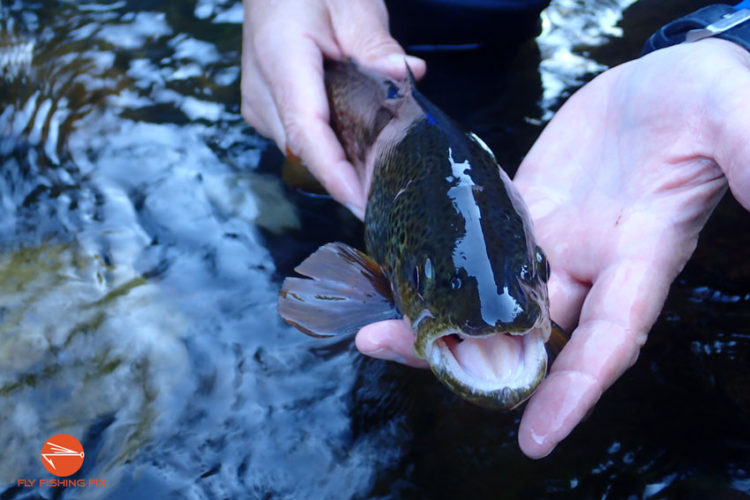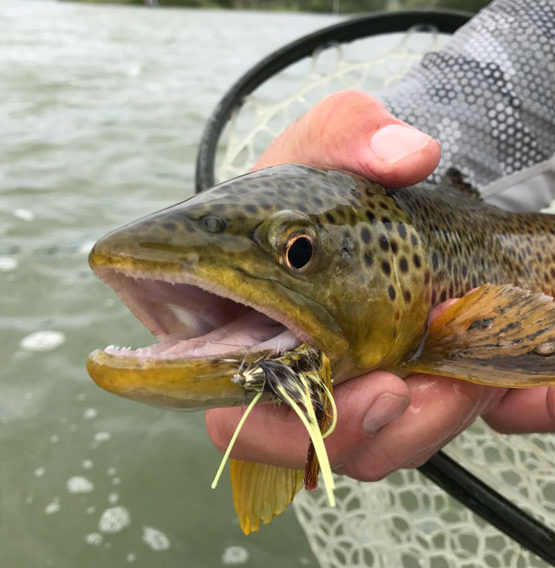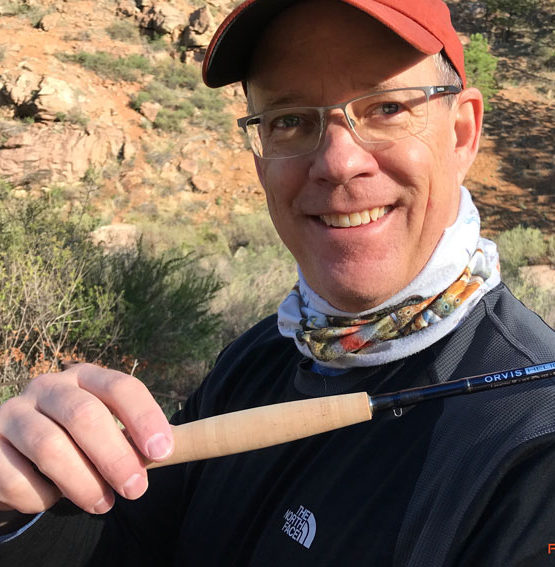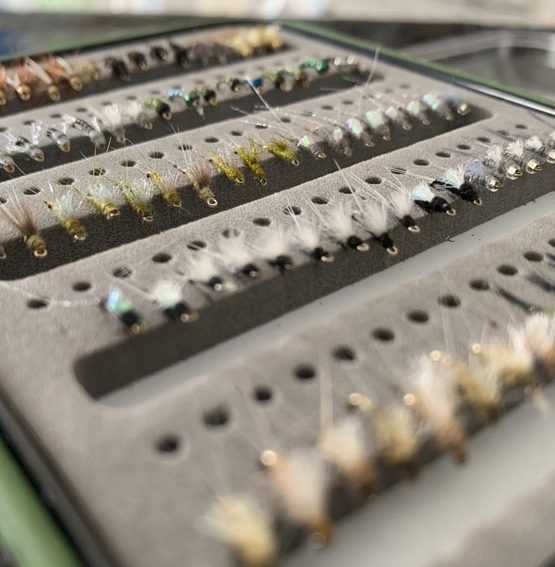The reason I decided to write this post is because, while there does seem to be a lot of uncertainty and, therefore, questions about this topic, there does not appear to be a lot of trustworthy answers, especially in light of all the new, advanced and prevalent photographic technology we all have at our fingertips. Although asked in different ways, the question for both new and more experienced anglers boils down to this: What is the best way to hold a trout for photos?
The best way to hold a trout for a photo is gently, quickly, wet handedly and while keeping it close to or in the water. Since it’s both presumptuous and impossible to assume that there is a single best way to hold a trout for something as subjective as a good photo, it’s best to approach this from a “what’s best for the fish” standpoint.
Therefore, in this post, while holding to the four basic principles noted above, we will attempt to cover how to hold trout for photos in different fly fishing situations. And, with tongue sometimes in cheek, we will offer several trout picture-taking thoughts and ideas to keep your fly fishing photo album from becoming just another yawn-inducing anthology of Joe Schmo’s grip-n-grins.
Disclaimer: This post may contain affiliate links, meaning we will receive a small commission (at no cost to you) if you click through and make a purchase.How To Handle Trout
Sad to say, but, despite the reverent depictions of fly fishing practitioners being oh so in-tune with the natural order; all of us seemingly at one with the essence of the river’s mysterious currents and the fish residing therein, indeed, their very divinely-appointed custodians, we are all, at times, guilty of mishandling trout.
And while the topic of how to properly handle trout commands a dedicated post unto itself, the rules of thumb come down to these following principles.
Don’t Exhaust Them
Playing a fish too long can harm or even kill them. This is especially true in warmer and shallower water. Playing trout is exciting and fun, but don’t make the mistake of thinking they need to be played-out and listless before you bring them into the net. This is stupid and, in my opinion, cruel.
Keep Them In The Water As Much As Possible
Here’s a startling revelation: without the aid of SCUBA equipment, we humans can’t breathe underwater. I know… stunning! Trout can’t breathe above the water. So, if you remember this rather elementary notion, when out of the water, fish are in the process of suffocating, you will be more mindful not to keep them there very long.
Be Careful Removing Your Hook
Ideally, you’ve crimped the barbs of your fly hooks down for easy, less damaging removals, but you still need to exercise care when removing them. Using your forceps (rather than your fingers) makes it easier to see what you’re doing while backing your hook out of the trout on the same path it took on the way in.
An additional benefit of a crimped hook is that it’ll be easier to back out of the fleshy base of your thumb when said trout decides to dart away, leaving said hook embedded in said thumb.
Another good tip for less eventful hook removal is to turn your trout upside down during the extraction process. Doing so briefly disorients them, which makes them more docile and amenable to the alarming situation in which they find themselves.
Avoid A Tight Squeeze
Though beautiful, trout are slimy, squirmy, strong and wily. They don’t give up just because they’ve landed in your net. And it’s uncanny how adept they are at delivering a freedom-or-bust twitch at the very instant you start to depress your camera’s shutter button. Because of this, along with our urgent desire to make sure we get the big guy photographed in front of our big toothy grins, it’s easy to squeeze them too hard.
Instead, keep them in your net, in the water, until you or your picture-taking partner is absolutely ready with the camera. Then, with wet hands, gently grasp their tail with one hand and lift them up from the underside with the other. (Assuming it’s tethered, let your net remain in the water below. You’ll probably need it to recapture a fumbled fish anyway.)
Avoid touching the trout’s gills and be careful not to wrench its fins or tail. Take a few pics and get it back in the water.
Revive And Release Them As Quickly As Possible
If a trout is exhausted, you may need to revive it. With one hand gently grabbing its tail, and with fish fully out of your net and completely under flowing and clean water, gently push and pull it back and forth in easy short strokes. You’ll know when it’s reviving when it starts to resist you to swim away. Make sure it’s fully revived before you completely let it go.
A recovered trout will usually dart away with a quick move, but some will saunter away slowly before they realize that the ordeal is over, then flee with greater purpose. By the way, the release makes for a cool slow-motion video. Keep reading.
Subscribe To Fly Fishing Fix, Today!
Trout Photo Mistakes
Want to look like a rank fly fishing amateur and, worse, have your amateur-ness on display for all to see from now until kingdom come? If so, make these easily-avoidable trout photo mistakes.
The Overhand Tail Grab
While an overhand tail grip is a smart way to handle a large trout, it is a mistake when taking pictures of small trout. Holding the back half of the trout with an overhand grip certainly reduces the likelihood of a squirm-induced fumble, but, instead of the full-length shot of a beautiful — albeit small — trout, the photo gives us a really nice view of the back of the angler’s hand.
Instead, assuming you want to take a broadside shot of your recently-caught trout, try to hold the fish from its underside, with both hands, and keep your fingers as inconspicuously placed as possible.
The Full Hand Block
Similar to the above but even more intrusive, this mistake occurs when both hands are covering too much of the trout. Regardless of overhand or underhand grip, we don’t want to see your digits in the picture, we want to see the trout!
The Over/Under Baseball Bat Grip
A more egregious variation of the full hand fish block, this mistake occurs when the angler covers most the front part of the trout with an overhand block and most of the back half of the fish with an underhand block (or vice versa). We see snout and tail and a whole lotta hand. No good.
The “Makes-It-Look-Small” Hold
Something weird happens to trout when we take pictures of them; they shrink! Somehow that monster we netted just doesn’t look quite as beefy in the photo as it did when we held it up for the photo.
One remedy for this every experienced fly fisher knows, is to hold the trout further away from his or her body and much closer to the camera! This works regardless of angle: broadside, head on, low angle, high angle, whatever… get the camera closer to the fish!
I mean, let’s face it, nobody really wants their monster to look small.
Related Content:
- Buying A Fly Rod: 5 Key Considerations
- 25 Proven Tips To Catch More Trout
- 21 Common Fly Fishing Mistakes To Avoid
- How Much Should You Tip A Fishing Guide?
- Fly Fishing With Small Flies (The Complete Guide)
- How To Read A River: 9 Tips To Catch More Trout
Standard Riverside Photo
The most commonly occuring trout photo is undoubtedly the river or lakeside, grip-n-grin, broadside shot. However, with such great photographic technology in the palms of our hands, people have become a lot more creative shooting fish at this locale. If you hold to the basic fish-handling principles, experimenting with different angles, poses and settings will produce a much more interesting post-adventure gallery.
A couple of things to be mindful of include:
- What to do with your rod while you get ready to photograph your catch: Underarm backwards tuck, set it down on the bank, rest it against a bush, have your buddy hold it, make sure you don’t step on it or trip on your line, etc.
- Whether or not to unhook the trout before taking the shot: It can be interesting and memorable to see the fly you used to catch it still in its mouth, but don’t leave it in there too long.
- Coming to terms with the inevitable fish fumble: More because of the angler’s awkward and goofy-looking expression, pictures of trout in mid-fumble can be rather funny. Although we all try hard not to drop a photo-worthy trout, it happens. Embrace the gaff. It’ll be a great addition to your photo album.
Floatin’ In The Boat Photo
Since many trout are caught from a drift boat or raft, it’s important to be aware of certain things when photographing such a catch. Again, keeping the welfare of the trout in mind, once you’ve played and reeled your hooked trout within range of the boat, try to avoid allowing it to bang up against the boat’s hull.
Using a longer boat net is a standard practice but, once the trout is in the net, it’s a good idea to let it stay in the net, in the water, until you’re ready with the camera. If you’re with a guide, it’s a good bet that, while you’re setting your rod down and getting ready to take a picture, he or she has already unhooked the fish and will lift the trout into the boat and serve it up to you when ready.
At this juncture, if your hands are not wet, carefully (without falling in or losing your iPhone to the deep) dip both of them into the water before touching your catch. Assuming either your guide or fishing companion is taking the shot, make sure they’re ready before picking the trout up from the net.
Although it will happen from time to time, try not to fumble when photographing a fish from inside a boat or raft. If you do drop it before getting the shot, consider sacrificing your photo to get the fish back in the water quicker; they’ve been through enough trauma already, don’t you think?
The Selfie
For obvious reasons, the trout selfie is a challenging undertaking, especially if you’ve landed a beefcake. But if no one else is nearby, the trout selfie might be your best still-shot (or video) option. A trout selfie will require some quick decision-making, so, at the risk of jinxing your landing it, it’s a good idea to plan ahead. While playing and reeling your fish, you’ll want to predetermine the following:
- Is this fish big enough to deserve a photo in the first place?
- What you’re planning to do with your rod.
- Where you’re going to land your fish so that it will be easy to keep it in your net, in the water until you’re ready.
- Whether or not you’re going to try to pick it up for a trout plus you selfie.
If you have decided to perform the classic “lay the trout next to your rod for length perspective” shot or not. If you do this, by the way, make sure you lay the fish in damp reeds (splash water on them if you have to) and take your photo quickly.
My experience with this kind of shot? Like toddlers during a Sears portrait shoot, trout don’t like to sit still for these next-to-rod photo sessions very long, so good luck!
Stylized
All of a sudden, about two years ago, we started to notice more fly fishing photos that looked like they were better suited for GQ’s Fall Fashion Issue than they were for Bill and Ted’s Excellent Fly Fishing Adventure.
These featured shots of guys and gals in poses that, if you backed the camera up, you’d likely see a director’s chair, Hollywood set lighting, a key-grip (whatever that is), and a phalanx of stylists and makeup artists in the background.
Gone were the happy smiles from rumpled fly fishers showing off their prize catch. In their place came photos of anglers adopting a new and bit too model-like style. I like to call it “scruffy-chic,” wherein brooding, mysteriously dark angler, not trout, becomes the photo’s focus.
I admit, while I could do without the pretentiousness, these stylized photos brought about new angles and innovative photographic effects that began to grow on me. Now, we’re all inspired, nay, compelled to experiment with something more interesting and stylish than the good ol’ grip-n-grin.
So, excuse me while I go work on my Madison Avenue facials.
Half-in/Half-out
Remember when getting your expensive handheld device wet was the dread of all anglers?
As soon as these palm-sized supercomputers came into being and, soon thereafter, the demand for water resistance, that went by the wayside rather quickly.
And while there were regular waterproof cameras back in the day, they were typically too cumbersome and too expensive for the average Joe to carry. Now that we can get our easily-carried iPhone or Galaxy devices wet, we’re able to execute the half-in/half-out (of water) closeup image of a trout.
This surface level split screen type of picture is a super cool way to enhance your fly fishing photo gallery. Give this technique a shot.
Underwater
Although a little trickier to get a good, clear image of a trout that is completely underwater, it’s fun to try. Assuming your camera is, indeed, waterproof to a certain depth (and that you have actually overcome the deeply-rooted terror of submerging the expensive little bugger) try taking several underwater shots on your next fly fishing adventure. You might be amazed with how they come out.
Don’t Forget About Videos
Years ago, before your typical handheld devices featured video capability, I purchased one of those little Flip video cameras. On the subsequent fly fishing trip, I pretty much ditched my camera and used the Flip almost exclusively.
Pretty sure my son and my other fishing buddies were more than a little annoyed with me taking so much live action that week. I was like a dad with a new baby to film. But, in the end, after I’d uploaded it to my computer and shared it with them, everyone loved having the footage.
We also found that video gave our non-fishing family members a much better understanding and appreciation for both the fly fishing settings and experiences.
Prior to that, our photographic trip review consisted of:
Here’s me with a rainbow I caught.
Here’s Zach with a brown he caught.
Here’s me again, with another big rainbow.
…Blah, blah, blah… yawn. With how easy it is to take video nowadays, it’s a crime not to.
The moral of this story? Take more fly fishing videos. Duh!
By the way, one of the coolest short videos you can take is the slow-mo trout release. Try it half-in/half-out (or underwater) too. Seeing the release and dart-away slow mo is awesome!
Final Reflections
I’ve touched on this throughout this post. Our incredibly advanced smartphones have nearly adhered themselves to our hands and yet most of us don’t have the faintest clue how to get the most out of them. Email, text, internet, phone, camera and how to use an app or three — that’s about the whole of it for me.
So let’s commit to learning more about what these things are fully capable of, especially when it comes to taking different and better photos (and videos) of trout! I mean, what else is there, besides family, friends, weddings, graduations, holidays, babies, vacations, sporting events, concerts, nature, sunsets, etc.
Get the picture?










